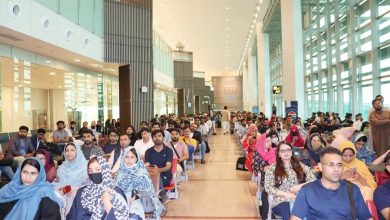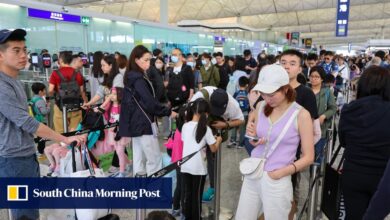Hong Kong’s Greater Bay Airlines aims to land staff from mainland China, tap affiliated carrier to ensure expansion plans fly

The bay area refers to Beijing’s initiative to integrate Hong Kong, Macau and nine mainland Chinese cities into an economic powerhouse.
Property tycoon Wong has pledged to invest HK$2 billion (US$258 million) in the new airline.
“We are getting eight or nine [first officers] to begin with, but as we go forward, there’ll be more opportunities for us to tap into their resources and that will, of course, help us to develop hopefully faster,” he said.
“We in Hong Kong are leveraging the resources available at Donghai, which is good for the two companies together. At the same time, we also bring in this new element of cooperation between entities in Hong Kong and also other entities in other parts of the Greater Bay Area.”
Greater Bay Airlines launches flights between Hong Kong and Ho Chi Minh City
Greater Bay Airlines launches flights between Hong Kong and Ho Chi Minh City
Both carriers used Boeing aircraft, making it easier to share parts, training and staff, Hui added.
GBA has four Boeing 737-800 jets, and will add another four aircraft starting from December. It aims to hire more than 100 pilots and cabin crew in the coming year.
Hui said the airline had “sufficient” numbers for expansion over the next six months, as it needed 10 pilots and 20 cabin crew per aircraft it brought in.
The carrier currently employs 50 pilots from Hong Kong, the mainland, Southeast Asia, South America and Europe.
“We’re getting very little interest from Australia, even the UK, also much less than before, which is, I think, an issue that we need to address,” he said.
“We really want the Hong Kong airline pilots’ community to be international … and that is why I think we’ll be very interested in recruiting more pilots from Australia and the UK in the coming months.”
Hong Kong’s Greater Bay Airlines to expand aircraft fleet ‘to 22 planes by 2027’
Hong Kong’s Greater Bay Airlines to expand aircraft fleet ‘to 22 planes by 2027’
Greater Bay Airlines announced in March it had ordered 15 Boeing 737-9 MAX aircraft. Hui said on Wednesday that the first delivery would take place in August next year.
The carrier has also signed a letter of intent to buy five Boeing 787 Dreamliners, which are popular with airlines for long-haul routes.
The airline said the fuel-efficient planes would reduce its carbon emissions by 20 per cent and form the backbone of its future fleet. It aims to have a fleet of 23 aircraft by 2027.
The new, spacious 737-9 planes, which can carry 200 passengers, will allow the company to offer business-class services for the first time.
Hui said he was aiming for Shanghai, Beijing and Tokyo as the first destinations for the new aircraft where he saw demand for leisure travel.
He said the airline’s next route would be Philippine capital Manila starting next month, which was expected to launch in August but faced delays in getting regulatory approval.
The carrier aims to fly to first-tier cities such as Beijing, Shanghai, Hangzhou and Chongqing “as early as possible” and is looking at next year but needs to secure airport slots.
“Our strategy is very simple. Go to first-tier cities where there is a demand. You want business, but at the same time, you also want to have a big market where you hopefully can carve out a niche for yourself,” Hui said, adding Manila was a “strong” example of this.
And they’re off! Hong Kong’s Greater Bay Airlines launches first flight to Osaka
And they’re off! Hong Kong’s Greater Bay Airlines launches first flight to Osaka
The carrier currently flies to six destinations – Ho Chi Minh City in Vietnam, Osaka and Tokyo in Japan, Taipei in Taiwan, Seoul in South Korea and Bangkok in Thailand.
Before going into the mainland, Hui said, the airline’s strategy was to be competitive on existing routes by increasing flight frequency, pointing to popular destination Taipei, with the carrier looking to make it a twice daily service.
Labour shortages at Japanese airports have, however, hampered efforts to boost its services to the country.
Over the summer the carrier’s passenger load factor – a measure of how well an airline is filling available seats – reached 70 to 80 per cent. A high load factor indicates an airline has sold most of its available seats.
Hong Kong’s Air Transport Licensing Authority last year awarded the carrier a five-year permit to operate commercial flights on 104 routes, including 48 to the mainland, as well as to Taiwan, Japan, South Korea and other destinations in the Asia-Pacific region.





